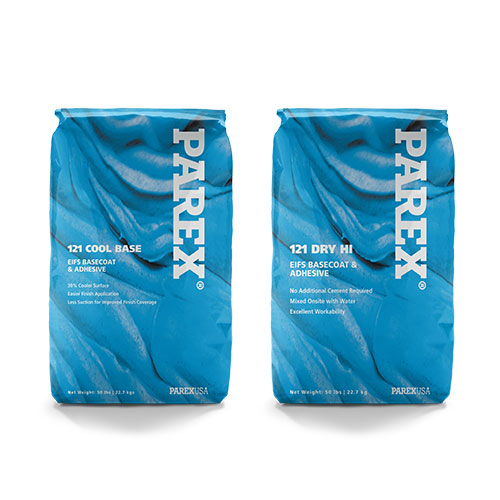Parex USA, Inc., the parent company of leading building material brands; Parex, Teifs, LaHabra, El Rey, and Merkrete, unveils two new Parex EIFS basecoats & adhesives – 121 Cool Base and 121 Dry HI (High Impact). Designed with the contractor in mind, the two new products boast extreme coolness and unsurpassed strength.
121 Cool Base is a premium, white EIFS basecoat and adhesive that is incomparable in the industry. It produces a 30 percent cooler basecoat temperature than typical basecoats & adhesives, which results in less suction and hydration when a final finish is applied. This technology allows for improved finish coverage as well as a faster and easier finish application.
“With the potential of improved finish coverage and ease of finish application, Parex’s new 121 Cool Base is set to make a big impact in the market,” said Heidi Larsen, Parex USA Product Manager. “When we presented a sneak peak of this product to contractors during our annual meeting, it was received with enthusiasm and overwhelming interest. Everyone was amazed at the drastic temperature differences between 121 Cool Base and standard EIFS basecoats & adhesives.”
Parex also introduces 121 Dry HI – a high performance EIFS basecoat and adhesive that is fortified with a unique blend of raw materials for increased impact and puncture resistance. It yields up to 30 percent better impact resistance (compared to standard EIFS basecoats & adhesives). 121 Dry HI is formulated for enhanced workability and provides easier application. This product is ideal for ground floors and other areas where greater impact resistance is required.
“In addition to providing 30 percent more impact resistance, 121 Dry HI also helps achieve higher ASTM/EIMA impact classifications,” said Larsen. “Typically, to achieve a “High” impact classification, a High Impact mesh (15 oz.) plus an additional layer of Standard Mesh (4.5 oz.) is required. Now, you can achieve a “High” impact classification utilizing a single layer of Intermediate Mesh (12 oz.) embedded in 121 Dry HI.” This system greatly reduces material and labor costs.
121 Cool Base and 121 Dry HI are one-component, polymer-modified, cement based dry products that are used as an adhesive to adhere EPS boards to existing substrates, a basecoat to embed reinforcing mesh and a leveler in Parex EIF Systems. Both 121 Cool Base and 121 Dry HI are shipped in 50 pound bags. Coverage, mixing instructions and limitations can be found in the Product Data Sheet at www.parex.com.
Related Stories
| Aug 11, 2010
Best AEC Firms of 2011/12
Later this year, we will launch Best AEC Firms 2012. We’re looking for firms that create truly positive workplaces for their AEC professionals and support staff. Keep an eye on this page for entry information. +
| Aug 11, 2010
AAMA leads development of BIM standard for fenestration products
The American Architectural Manufacturers Association’s newly formed BIM Task Group met during the AAMA National Fall Conference to discuss the need for an BIM standard for nonresidential fenestration products.
| Aug 11, 2010
Embassy's dual façades add security and beauty
The British government's new 46,285-sf embassy building in Warsaw, Poland's diplomatic quarter houses the ambassador's offices, the consulate, and visa services on three floors. The $20 million Modernist design by London-based Tony Fretton Architects features a double façade—an inner concrete super structure and an outer curtain wall.
| Aug 11, 2010
Precast All the Way
For years, precast concrete has been viewed as a mass-produced product with no personality or visual appeal—the vanilla of building materials. Thanks to recent technological innovations in precast molds and thin veneers, however, that image is changing. As precast—concrete building components that are poured and molded offsite—continues to develop a vibrant personality all it...
| Aug 11, 2010
Seven tips for specifying and designing with insulated metal wall panels
Insulated metal panels, or IMPs, have been a popular exterior wall cladding choice for more than 30 years. These sandwich panels are composed of liquid insulating foam, such as polyurethane, injected between two aluminum or steel metal face panels to form a solid, monolithic unit. The result is a lightweight, highly insulated (R-14 to R-30, depending on the thickness of the panel) exterior clad...
| Aug 11, 2010
Nurturing the Community
The best seat in the house at the new Seahawks Stadium in Seattle isn't on the 50-yard line. It's in the southeast corner, at the very top of the upper bowl. "From there you have a corner-to-corner view of the field and an inspiring grasp of the surrounding city," says Kelly Kerns, project leader with architect/engineer Ellerbe Becket, Kansas City, Mo.
| Aug 11, 2010
AIA Course: Enclosure strategies for better buildings
Sustainability and energy efficiency depend not only on the overall design but also on the building's enclosure system. Whether it's via better air-infiltration control, thermal insulation, and moisture control, or more advanced strategies such as active façades with automated shading and venting or novel enclosure types such as double walls, Building Teams are delivering more efficient, better performing, and healthier building enclosures.







